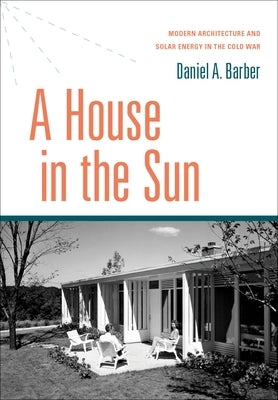1
/
of
1
Oxford University Press, USA
A House in the Sun: Modern Architecture and Solar Energy in the Cold War
A House in the Sun: Modern Architecture and Solar Energy in the Cold War
Regular price
€76,95 EUR
Regular price
Sale price
€76,95 EUR
Shipping calculated at checkout.
Quantity
Couldn't load pickup availability
A House in the Sun describes a number of experiments in solar house heating in American architectural, engineering, political, economic, and corporate contexts from the beginning of World War II until the late 1950s. Houses were built across the Midwest, Northeast, and Southwestern United
States, and also proposed for sites in India, South Africa, and Morocco. These experiments developed in parallel to transformations in the discussion of modern architecture, relying on new materials and design ideas for both energy efficiency and claims to cultural relevance. Architects were among
the myriad cultural and scientific actors to see the solar house as an important designed element of the American future. These experiments also developed as part of a wider analysis of the globe as an interconnected geophysical system. Perceived resource limitations in the immediate postwar period
led to new understandings of the relationship between energy, technology and economy. The solar house - both as a charged object in the milieu of suburban expansion, and as a means to raise the standard of living in developing economies - became an important site for social, technological, and
design experimentation. This led to new forms of expertise in architecture and other professions. Daniel Barber argues that this mid-century interest in solar energy was one of the first episodes in which resource limitations were seen as an opportunity for design to attain new relevance for potential social and cultural transformations. Furthermore, the solar discussion established both an
intellectual framework and a funding structure for the articulation of and response to global environmental concerns in subsequent decades. In presenting evidence of resource tensions at the beginning of the Cold War, the book offers a new perspective on the histories of architecture, technology,
and environmentalism, one more fully entangled with the often competing dynamics of geopolitical and geophysical pressures.
Author: Daniel A. Barber
Publisher: Oxford University Press, USA
Published: 11/10/2016
Pages: 352
Binding Type: Hardcover
Weight: 2.15lbs
Size: 10.10h x 7.10w x 0.80d
ISBN: 9780199394012
Review Citation(s):
Choice 05/01/2017
States, and also proposed for sites in India, South Africa, and Morocco. These experiments developed in parallel to transformations in the discussion of modern architecture, relying on new materials and design ideas for both energy efficiency and claims to cultural relevance. Architects were among
the myriad cultural and scientific actors to see the solar house as an important designed element of the American future. These experiments also developed as part of a wider analysis of the globe as an interconnected geophysical system. Perceived resource limitations in the immediate postwar period
led to new understandings of the relationship between energy, technology and economy. The solar house - both as a charged object in the milieu of suburban expansion, and as a means to raise the standard of living in developing economies - became an important site for social, technological, and
design experimentation. This led to new forms of expertise in architecture and other professions. Daniel Barber argues that this mid-century interest in solar energy was one of the first episodes in which resource limitations were seen as an opportunity for design to attain new relevance for potential social and cultural transformations. Furthermore, the solar discussion established both an
intellectual framework and a funding structure for the articulation of and response to global environmental concerns in subsequent decades. In presenting evidence of resource tensions at the beginning of the Cold War, the book offers a new perspective on the histories of architecture, technology,
and environmentalism, one more fully entangled with the often competing dynamics of geopolitical and geophysical pressures.
Author: Daniel A. Barber
Publisher: Oxford University Press, USA
Published: 11/10/2016
Pages: 352
Binding Type: Hardcover
Weight: 2.15lbs
Size: 10.10h x 7.10w x 0.80d
ISBN: 9780199394012
Review Citation(s):
Choice 05/01/2017
About the Author
Daniel A. Barber is an Assistant Professor of Architecture at the University of Pennsylvania, where he teaches the history of modern architecture. He has published articles in Grey Room and Technology and Culture.
This title is not returnable
Share


